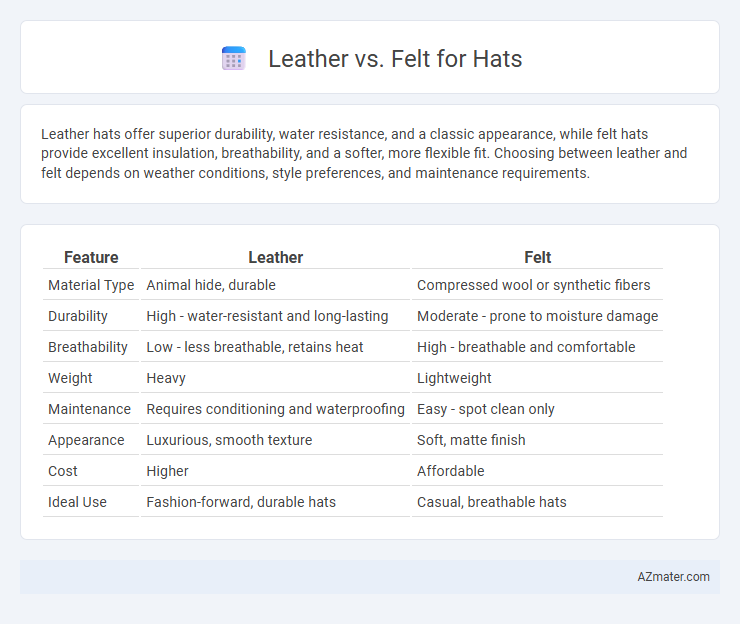Leather hats offer superior durability, water resistance, and a classic appearance, while felt hats provide excellent insulation, breathability, and a softer, more flexible fit. Choosing between leather and felt depends on weather conditions, style preferences, and maintenance requirements.
Table of Comparison
| Feature | Leather | Felt |
|---|---|---|
| Material Type | Animal hide, durable | Compressed wool or synthetic fibers |
| Durability | High - water-resistant and long-lasting | Moderate - prone to moisture damage |
| Breathability | Low - less breathable, retains heat | High - breathable and comfortable |
| Weight | Heavy | Lightweight |
| Maintenance | Requires conditioning and waterproofing | Easy - spot clean only |
| Appearance | Luxurious, smooth texture | Soft, matte finish |
| Cost | Higher | Affordable |
| Ideal Use | Fashion-forward, durable hats | Casual, breathable hats |
Introduction to Hat Materials
Leather offers durability, water resistance, and a classic, rugged aesthetic ideal for structured hats, while felt provides a soft texture, excellent insulation, and versatile styles suited for both casual and formal headwear. Felt is commonly crafted from wool, fur, or a blend, delivering breathability and flexibility, whereas leather hats excel in longevity and weather protection. Choosing between leather and felt depends on factors like climate, comfort preferences, and the desired hat silhouette.
Key Differences Between Leather and Felt
Leather hats offer superior durability, water resistance, and a sleek, polished appearance, making them ideal for outdoor use and rugged fashion. Felt hats, typically made from wool or fur, provide better breathability, flexibility, and lightweight comfort, which suits extended wear and varied climates. The key differences lie in material composition, moisture handling, and style versatility, with leather excelling in toughness and felt dominating in softness and temperature regulation.
Durability Comparison: Leather vs Felt
Leather hats exhibit superior durability compared to felt, as leather is more resistant to wear, moisture, and tearing, making it ideal for long-term use. Felt hats, while comfortable and lightweight, tend to degrade faster under harsh weather conditions and prolonged exposure to moisture. The dense, fibrous structure of felt offers less protection against abrasions than the robust grain of leather, resulting in leather hats maintaining their shape and appearance significantly longer.
Comfort and Fit Considerations
Leather hats offer a snug, durable fit that molds to the head over time, providing personalized comfort and excellent wind resistance. Felt hats, typically made from wool or fur fibers, are lightweight and breathable, ensuring comfort during extended wear and adaptability to various head shapes. Choosing between leather and felt depends on balancing the durable, form-fitting qualities of leather against the soft, flexible nature of felt for optimal comfort and fit.
Weather Resistance and Seasonal Suitability
Leather hats provide excellent weather resistance due to their natural water-repellent properties and durability, making them ideal for rainy or windy conditions. Felt hats offer moderate water resistance and are better suited for cooler, dry climates as they provide warmth and breathability during fall and winter seasons. Choosing between leather and felt depends on whether protection from harsh weather or seasonal comfort is the priority.
Style and Appearance Factors
Leather hats exude a sleek, rugged appeal with a glossy finish and natural texture that ages beautifully, making them ideal for a bold and sophisticated style statement. Felt hats offer a soft, matte surface available in various colors, providing versatile elegance and a timeless look suited for both casual and formal wear. The choice between leather and felt influences the hat's overall aesthetic, with leather enhancing durability and a modern edge, while felt ensures classic charm and refined comfort.
Maintenance and Cleaning Tips
Leather hats require gentle cleaning with a damp cloth and occasional conditioning using leather-specific products to maintain suppleness and prevent cracking. Felt hats should be brushed regularly with a soft-bristle brush to remove dust and dirt, while stains can be treated with a mild soap solution and careful spot cleaning. Both materials benefit from proper storage away from direct sunlight and moisture to preserve shape and durability.
Cost and Value Assessment
Leather hats generally have a higher upfront cost due to premium materials and craftsmanship, offering durability and a distinctive aesthetic that can increase long-term value. Felt hats tend to be more budget-friendly, providing good insulation and lightweight comfort, making them ideal for everyday use without significant investment. Evaluating cost against value, leather hats are an investment in longevity and style, whereas felt hats offer affordability and versatile practicality.
Best Uses for Leather Hats
Leather hats excel in durability, water resistance, and wind protection, making them ideal for outdoor activities such as horseback riding, hiking, and motorcycling. Their robust material also provides excellent shape retention and a rugged aesthetic suited for casual or workwear environments. Leather's natural breathability and ability to develop a unique patina enhance comfort and style over time, perfect for those seeking longevity and character in their headwear.
Best Uses for Felt Hats
Felt hats excel in retaining warmth and providing water resistance, making them ideal for cold and rainy weather conditions. Their soft texture and pliability allow for versatile fashion styles and comfortable all-day wear. Felt hats are best suited for outdoor activities like hiking, hunting, and fall or winter casual outings where both style and protection are needed.

Infographic: Leather vs Felt for Hat
 azmater.com
azmater.com